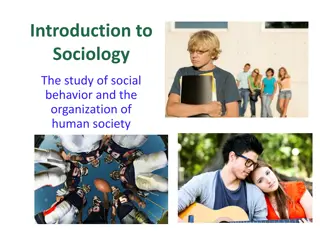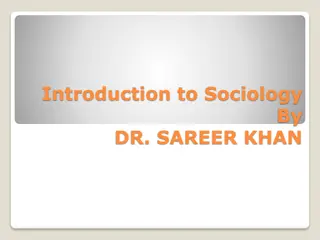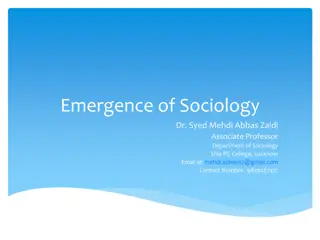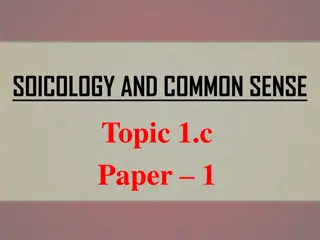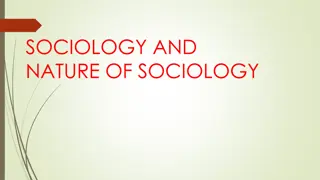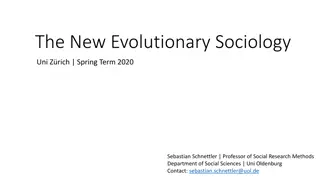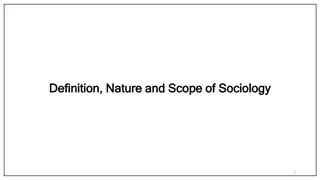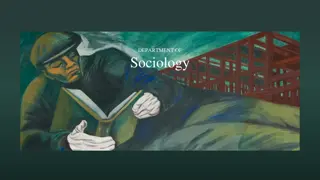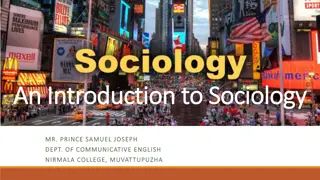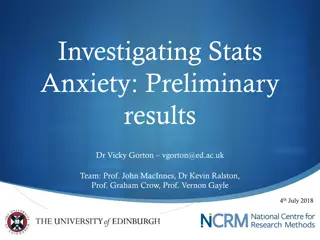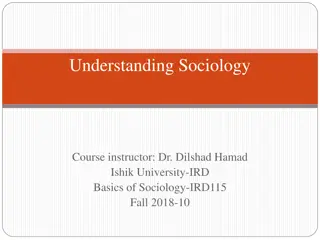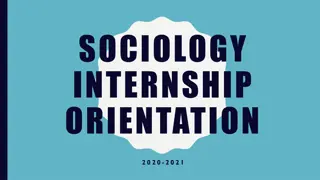Understanding Community Studies in American Sociology
Community studies in American sociology focus on analyzing life within specific neighborhoods, dating back to the 1920s. This field employs various research methods to explore social aspects extensively, building on anthropological urban ethnography. Early studies by influential figures like W.E.B. DuBois and the Chicago School of Community Studies have shaped the discipline. The concept of "natural communities" and the development of folkways and mores are key aspects in understanding community dynamics. Additionally, classical theories by sociologists like Tonnies and Durkheim provide valuable insights into traditional versus modern societies and the division of labor.
- Community Studies
- American Sociology
- Neighborhood Analysis
- Social Research
- Classical Sociological Theories
Download Presentation

Please find below an Image/Link to download the presentation.
The content on the website is provided AS IS for your information and personal use only. It may not be sold, licensed, or shared on other websites without obtaining consent from the author. Download presentation by click this link. If you encounter any issues during the download, it is possible that the publisher has removed the file from their server.
E N D
Presentation Transcript
Sociology 312 American Society Community Studies
What Are Community Studies? "Community" refers to a population defined by its geographic location people who live and work together see Park and Burgess, 1921, p. 163 American Sociology has long tradition of community studies
Community Studies intensive analysis of life in a particular place: usually a neighborhood within a city studies dating back to the 1920s extensive within place, covering various aspects of social life generally used multiple methods: archival, survey, participant observation offered rich description building on anthropology, Clifford Geertz urban ethnography: our own Brian Kelley
The earliest community study was The Philadelphia Negro W. E. B. DuBois conducted the research in 1897 Later, the Chicago School of Community Studies inspired by Robert Park and his colleagues at the University of Chicago where Park was a professor, 1913-1934
"Natural Communities" Early 20th C U.S. Sociology dominated by evolutionary theory (Spencer) defended by William Sumner conservative professor at Yale taught first sociology course in 1875 Sumner and his colleagues viewed communities as natural societies that evolved by developing "folkways" and "mores"
Folkways and Mores Folkways (Burgess and Park, pp. 100-111) "habitual ways of doing things" develop through trial and error more adaptive selected and become "sanctioned" as "mores" become obligations enforced by reward and punishment Institutions develop to maintain these behaviors
Other Classical Theories Tonnies, Community and Society (1887) traditional versus modern personal versus impersonal, etc. Durkheim, Division of Labor (1893) simple and complex societies mechanical and organic solidarity functional model of society
Functional Model - Social Similarity + Mechanical Solidarity - increasing social density
Chicago School Park and his more liberal colleagues challenged the evolutionary theory of natural communities characterized as homogeneous (sameness) threatened by urbanization and increasing diversity of modern cities, such as Chicago in 1920s the "death of community" thesis
Urban Ecology Park argued that there are "natural area" in the city (Park, 1967, p. 9) they develop without planning they serve a function (e.g., transportation) various functions populations and activities, are in competition for space the most adaptive and resourceful win the competition for the most valuable spaces
The Urban Mosaic pattern and order result from competition finance and trade: dominant functions tend to occupy central location factories are located on major transportation lines working class neighborhoods near factories more marginal (slum) areas: deteriorating buildings house newly arrived immigrants nearby is bohemia: artists and radicals
Chicago in 1920 gold coast slum working class warehouses River Industry working class finance and trade transportation Lake Michigan middle class residential ethnic communities University of Chicago slum slum working class ethnic Gary, IN steel mills
Natural organization of city determined by geography and transportation lakes and rivers later, canals still later, Railroads finally, interstate highways Cities vary by when they were built walking city: 18th century railroad city: 19th century freeway city: 20th century
How Cities Change Ecological Processes competition: driving force dominance: most powerful functions invasion: new activity or population enters established community (natural area) waves of immigrants expansion of strip malls and fast food succession: new activitiy becomes dominant takes over community/area
Succession suburbanization: housing moves out of city, following highways commerce and industry follows deterioration/gentrification abandoned residences, warehouses and industrial buildings deteriorate into slum warehouses and industrial buildings become lofts and apartments; residences are refurbished by young urban professionals
Urban Ecology (conclusion) major transformation in the organization of urban/community space results from new technologies which decrease the time/cost of transportation and reduce the value of central location some claim that the post-industrial, information city of the 21st Century will be de- centered a virtual center that exists only in cyber space
Middletown: The Canon Robert and Helen Lynd published Middletown in 1929 Middletown in Transition in 1937 These were the first wave of Now four waves of Middletown Studies Middletown Studies Center and archive now established in at Ball State Community section of ASA offers Robert and Helen Lynd Lifetime Achievement award
Community Politics Pluralism: dominant perspective, 1950-70 competing leaders logrolling/helping out greatest good for greatest number protection of minority interests Multiple interests multi-faceted issue specific cross-cutting
Cross-Cutting Solidarity Self-employed Non-Hispanic White Female
Self-Employed by Race and Sex in 2012 (N=99,315) Self Employed 49% (4,161) 27% (2,274) 16% (1,343) 9% (788) 100% (8,566) Employee 33% (29,717) 32% (28,609) 18% (16,267) 18% (16,156) 100% (90,749) Total 34% (33,878) 31% (30,883) 18% (17,610) 17% (16,944) 100% (99,315) Anglo Male Anglo Female Other Male Other Female Total Source: Current Population Survey, March Supplement, 2012
Another Look at Race, Class, and Gender Self Employed 12% (4,161) 7% (2,274) 8% (1,343) 5% (788) 9% (8,566) Employee 88% (29,717) 93% (28,609) 92% (16,267) 95% (16,156) 91% (90,749) Total 100% (33,878) 100% (30,883) 100% (17,610) 100% (16,944) 100% (99,315) Anglo Male Anglo Female Other Male Other Female Total Source: Current Population Survey, March Supplement, 2012
Robert Dahl Robert Dahl, Who Governs? (1961) New Haven, CN (Yale) Variety of methods to study political influence Social class or status of local officials Participation of notables (New Haven Lawn Club members)
Who Governs? (continued) Multiple methods (continued) Type of people involved in decisions in different issue areas public education urban redevelopment Party nominations Random samples of participants in each area survey for social characteristics Analyze election returns by social class of precincts Random sample of voters: participation
Findings Very few (Leaders) have direct influence can initiate or veto policies a. leaders have assistants and sub-leaders b. leaders appeal to and shape interests of voters c. most people have indirect influence Leaders and sub-leaders are highly specialized in issue areas
Highly specialized (continued) Fifty actors initiated/vetoed policies (p. 182) - 27: (54%): only one success - 17: (34%) 2-3 in single issue area - 3: (06%) 4 or more successes, single area - 3: (06%) 4 or more, multiple areas Fifty successful leaders succeeded in - nomination decisions (13 leaders) - public education decisions (16 leaders) - urban redevelopment decisions (26 leaders) Only Mayor was influential in all three areas
Duplication in Counting Leaders Leaders (Actors) by Number of Successes Initiating or Vetoing by Issue Area Number of Successes One 2-3 4 or more Total Re- development 73% (19) 19% (05) 08% (02) 100% (26) Party Nomination 31% (04) 31% (04) 38% (05) 100% (13) Public Education 44% (07) 50% (08) 06% (01) 100% (16) Total 54% (30*) 31% (17) 15% (08**) 100% (55***) * Three duplications: actors with one success in two or three areas ** Two duplications: actors with multiple success in two or three areas *** Total of five duplications
Leaders: Diverse Backgrounds 27 (54%) were public officials 13 (26%) were notables or corporations 12 (24%) were others (general public) N=52 (two public officials were notables)
Four Patterns of Leadership 1: Executive centered grand coalition of coalitions 2: Coalition of chieftains 3: Independent sovereigns with separate spheres of influence 4: Rival sovereigns fighting it out Covert integration by economic notables networks of ruling elites, did not occur
Diverse Resources Available Almost all were unequally distributed Wealthy in one were poor in another No resources universally applicable Nobody with all or none (pp. 226-228). Resources include: time, money, jobs, information, status, popularity, legal rights, authority, legitimacy, votes, educ., IQ, etc.
Major Changes in Governing Biggest change: rise of professionals and importance of skill and art of pyramiding notables declining in influence executives increasingly important coalition building is now critical Executive centered coalition of coalition is becoming dominant form Institutionalized in city manager, professional government in modern cities
Challenge to Pluralism: Ruling Elite Studies Floyd Hunter s study of Atlanta, Community Power Structure (1953) is the classic study of elite networks and elite domination of public policy Dorothy Nehil s study of Boston indicates elite domination through networks of business and political elites Bachrach and Baratz (1962) classic on nondecisions promoted by elites
Ruling Elite Studies (continued) Matthew Crenson, Unpolitics of Air Pollution (1971): pollution remained a non-issue in the most polluted cities Robert Perrucci and Marc Pillisuk (ASR 1970): inter-organizational leaders, served on multiple corporate boards, linked these orgs Had a reputation for local power Had similar attitudes and interests in local politics
Pluralist Versus Ruling Elite and Functional versus Conflict Models Methodological distinctions Pluralist focus on public policy decisions and public meetings Ruling elite focus on inter-organizational networks and reputation for power/influence
Debate (continued) Theoretical arguments Liberals argue that poor people or non-elites have to fight their way into the polity Elites promote non-decisions/status quo Political challenges predicted by Interests Organization opportunity Political challenges produce social change
Pluralist vs. Elite Theory Peter Bachrach and Morton Barztz, The Two Faces of Power, American Political Science Review, LVII (Dec. 1962):947-52 Two faces of power: public and private Pluralists study public face: city council meetings Conflict/ruling elite theorists study private face: elite networks Each finds what he looks for, because both exist
Hogan (1982, 1990) My dissertation (U of M 1982) expanded on two faces of power Typology of frontier communities Carnival of public government Caucus of private government Difference rooted in economic organization and political culture Carnival towns: Denver and Central City Economic independence of artisans/miners Tradition of political organization and contention
My dissertation (continued) Caucus towns: Golden and Pueblo (home of Adolph Coors, Rockefeller, Railroads, Guggenheim Brothers, Bessemer Coal, Oil & Iron Mfg) tradition of corporate economic control and government by caucus of business elites Carnival/Caucus frontier character continues to shape local political economy
Hogan (2003) More recent book: Failure of Planning (2003) Acknowledges public and private faces of government in all communities Maintains variation across communities Rooted in economic organization and political experience/culture
Growth Machine John Logan and Harvey Molotch (1987), Urban Fortunes Modern city is a growth machine Developers and industrialists hold city hostage Cities must promote growth or become ghost towns
Failure of Planning (2003) Recently I have been arguing (in print) with John Logan on extent to which Cities always support growth Citizen growth control initiatives inevitably fail My argument: growth initiatives emerge in cities experiencing overbuilding: hh/pop growth In South CA in 1980s
Southern CA in 1980s (cont.) Following early risers: Petaluma and Rockland Counties in 1970s Taking advantage of boom years of speculative frenzy (Reagan years, just before savings and loan crash of 1989) Most challenged suburban cities Faced organized citizens: initiative on ballot Substantial state demands for new housing and for affordable housing
Castleton (made up name of real San Diego suburb) Particularly challenged but managed to pre-empt the citizens Developers came up with alternative plan New housing permitted in planned developments Developer/new residents would pay for public services: water, power, even schools and parks All provided (including planning experts) by the developer
Castleton Miracle How was this possible? City had lots of vacant land That was becoming increasingly valuable Including coastal view estate lots, looking out to ocean from above the edge of a lagoon Developers were anxious to build Before the bottom fell out of the real estate market
What Happened? Local facilities planning districts were developed by eager developers in 1986- 1989 After 1989 all building stopped savings and loan crashed Lots of meetings and plans, 1990-1995 Citizen advisory committees Negotiating with developers
Planning 1990-1995 (continued) Two faces of power were much evident citizen advisory committees and workshops Private meetings with developers Managing popular participation Co-opt the organized Pre-empt the disorganized (but potentially powerful/threatening)
Planning 1990-1995 (continued) Follow cycles Pre-empt during boom Co-opt during bust Growth control Smart Growth 1996 2008 1980 1990
The Failure of Planning (cont.) The benefits of over-regulation The contradictory interests in community life: exclusionary work: inclusionary The interest of local government is managing inclusionary and exclusionary interests The irony of popular participation
The Failure of Planning (concl.) Local government Manages public opinion and voters Co-opts organized Pre-empts organizing Co-opts during bust Pre-empts during boom Developers: building rights during boom Cooperate with government Pre-empt opposition
Aldon Morris and Community Studies My goal is to locate Morris analysis of the Civil Rights Movement In community studies In political sociology How does Morris indigenous approach explain how the black community succeeded in challenging Jim Crow?
Morris on community How does Morris inform our analysis of community? the death of community? Urban ecology? Community politics Pluralism Conflict/ruling elite theory Historical/comparative Growth machine How does this inform political sociology?




